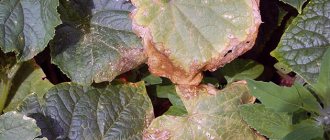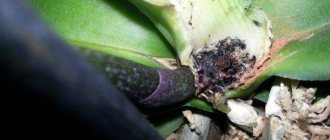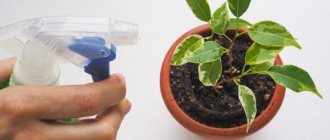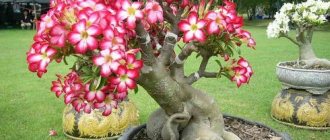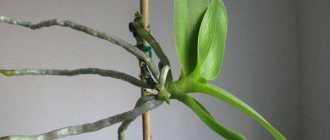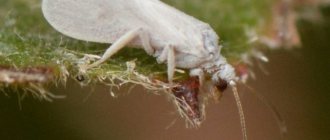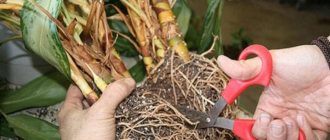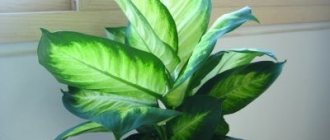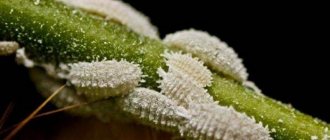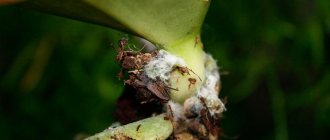Let us immediately note the fact that most species of this orchid, especially those with large beautiful flowers, are capricious, especially during the flowering period. If you do not have sufficient experience in growing tropical exotics, we recommend starting with the most unpretentious orchid, the care of which is presented in detail in the article “Dendrobium Nobile Orchid - Care and propagation at home.” Besides it, numerous Dendrobium hybrids are most adapted to living conditions in our apartments. They have similar recommendations for home care, which we will introduce you to now.
Causes of problems at home
The beginning of the development of the disease can be tracked by the leaves of the plant. They instantly react to any negative processes.
Orchids are susceptible to many diseases. Conventionally, they can be divided into four large groups:
- Infectious diseases - the causative agents are fungi that develop in excessively moist soil and unventilated areas. If conditions do not change, fungi develop very quickly. The roots begin to rot first, then the stems and leaves.
- Non-infectious diseases are a consequence of the orchid being exposed to low temperatures. The plates react to such conditions with dark spots.
- Diseases caused by bacteria develop in conditions of stagnant moisture in the soil and air. Bacteria penetrate into the orchid through damaged areas of a weakened plant and disrupt its metabolic processes. All this quickly leads to necrosis.
- Diseases that develop after viral exposure are the most dangerous. A plant infected with a virus should be destroyed immediately so that neighboring flowers are not harmed. A viral disease can only be detected in a special laboratory. The disease appears as spots on the outside of the plates and stem. The most common are: cymbidium mosaic virus, viral spot virus, ring mosaic virus.
Treatment Options
From the moment an orchid is infected until the first symptoms of the disease appear, a certain amount of time passes, different for individual species - from 3 to 6 weeks. Immediately after the disease manifests itself, the infected plant is isolated from other house flowers, and the window sill where it stood is thoroughly washed with water containing hydrogen peroxide or bleach diluted in it.
The affected areas are cut off to healthy tissue, and the cut areas are treated with brilliant green or sprinkled with cinnamon or powdered charcoal. Tools must be thoroughly disinfected with alcohol or heated over a flame so as not to spread spores to all home flowers, and hands must be washed well with soap. The plant should then be treated with one of the fungicides, such as kresoxim-methyl, bromuconazole or mancozeb. For small lesions, you can use copper-based preparations - Bordeaux mixture, copper oxychloride, copper sulfate and others.
In addition to drastic means, in the fight against phyllosticosis, one should not forget about optimizing housing conditions, since even effective fungicides will not help save a plant that has not been moved from a semi-shaded place to a more illuminated one. Orchids of the genera Vanda and Cymbidium are difficult to treat because, due to the structure of the leaves, the disease may not manifest itself for more than 12 months. However, plants with a spot that appears harmless at first glance and does not change for a long time can turn out to be a real disaster for other orchids in the neighborhood.
Care and how to treat if spots appear?
As already mentioned, leaves are an indicator of the health of the orchid. Spots or plaque that appear on them indicate problems with the internal processes of the orchid. Therefore, such manifestations cannot be ignored.
Timely detected diseases reduce the risk of flower death by 70%.
Let's look at the most common orchid diseases and their external manifestations.
Dark and brown
Dark and brown formations indicate serious diseases. They can be either greasy and wet or dry.
Dry spots indicate excessive humidity in the room. Such a signal cannot be ignored, otherwise the disease will spread and the spots will invade new areas of the tropical plant.
Brown, wet and greasy formations indicate brown rot of the flower. This disease starts from the root and then spreads to the leaves. When the leaf is completely covered with such a stain, it must be removed and treatment of the plant begins.
Black around the edges and at the tip
The appearance of black spots on an orchid is far from uncommon. If black spots have developed from small purple dots, this is an indication of overwatering. It is worth adjusting the care of the flower.
The cause of black spots may be the development of chlorosis. In this case, the plate begins to turn black from the tip and gradually spreads across the sheet, twisting them.
A fungal infection can also cause black spots to form.
Such spots look like peas and appear on the inside of the plate and gradually cover it, causing the death of the entire sheet. In this case, it is necessary to remove the infected area and treat it with a fungicide.
Yellow or light
Improper maintenance of the plant will cause yellow spots to appear. The reason for this is exposure to sunlight. The treatment would be to move the pot to partial shade. Yellow formations with black dots indicate exposure to infection.
It is not uncommon for orchids to suffer from large yellow convex spots that seem to press through the texture of the leaf and gradually grow. The disease can be cured only with proper care and the use of suitable water for irrigation.
Yellow spots also indicate a fungal disease, which arose due to high humidity and poor ventilation of the room.
Read more about how to treat leaves of a phalaenopsis orchid here.
What does the Dendrobium Nobile orchid look like?
The Dendrobium Nobile orchid, also known to gardeners as the “noble” orchid, belongs to one of the many genera that make up the Orchidaceae family. The first scientifically described specimens were discovered in India. In general, the homeland of most plant species is Southeast Asia (Thailand, Cambodia, Vietnam). In nature, the plant lives in tropical forests, is an epiphyte or lithophyte, that is, it settles on tree trunks or rocks, clinging with its roots to the smallest cracks in the bark and stones. The orchid is not a parasite; it needs the “owner” only as a support. The plant is quite hardy and can survive without water for about a month.
In nature, the dendrobium Nobile orchid most often lives in trees.
The peduncles of the dendrobium Nobile orchid are straight and branched. Sometimes they even bend under the weight of numerous buds. The petals are most often colored snow-white, pale lemon, golden-orange, lilac, violet. The diameter of the flower varies from 4 cm to 8–10 cm. It has a very subtle pleasant aroma.
Most often, the petals of the dendrobium Nobile orchid combine several shades, creating a unique play of colors
The plant has successfully adapted to the conditions of modern apartments. The orchid is deservedly considered to be quite capricious, so it is better for the gardener to first practice on less demanding representatives of the family. Suitable for beginner orchids are phalaenopsis and cattleya.
- advantages: blooms often and abundantly, easily propagated;
- disadvantages: does not like dry air, the smell of dendrobium causes allergies in some people.
Dendrobium Nobile belongs to the so-called sympodial orchids - its growth point is at the top of the shoot
Many breeding hybrids have been created based on the dendrobium Nobile orchid. Most of them come from Japan (the so-called Yamamoto group) or from the Netherlands. They differ from “natural” orchids in having larger flowers.
Photo gallery: achievements of breeders
Dendrobium Nobile Anna Green has a crimson-purple lip that stands out effectively against the background of bright lime-colored petals. Petals of dendrobium Nobile Black Beauty have a rich purple tone, sometimes with a chocolate tint, but from a distance they seem almost black. Dendrobium Nobile Jade Green is one of the most popular breeding hybrids Orchid dendrobium NobileLemon Green has a rich, pleasant aroma. Dendrobium Nobile Snow White has a very pure snow-white shade of petals and lips. Blooming dendrobium Nobile Firebird is a real golden-orange “waterfall”
Sticky sweet drops
Sticky sweet drops do not always indicate an orchid disease. The flower may secrete nectar to attract insects for pollination.
In the case of a flower disease, sticky formations may arise from excessive moisture. The flower thus gets rid of excess moisture.
The appearance of spots can also be a defense mechanism against pests or protection from burns from direct sun rays.
White plaque
White plaque is a signal of powdery mildew disease. Spots on the leaves appear gradually, but over time they will cover the entire ground layer of the orchid. The culprit is the mealybug, which feeds on the sap of the plant and produces a harmful toxin.
In addition to using medications to treat powdery mildew, it is necessary to change the soil. Pests can hide in the pores.
Pests
If not properly cared for, Dendrobium Nobile is susceptible to pest attacks. The main ones can be considered:
- Aphids that are simply washed off.
- Spider mites, when thin webs can be seen. Treatment with substances containing alcohol helps, which must be washed off after half an hour.
It is sometimes difficult to completely get rid of such phenomena. Therefore, in difficult situations it is necessary to use chemicals. This will preserve Dendrobium Nobile its natural beauty and strength.
Share
Why does it bloom, but the plates dry, wither and fall off?
Problems with an orchid's leaf system are always the result of improper care.
Main causes of diseases:
- overheat;
- frostbite or a long period of exposure to a draft;
- not regular watering, which led to drought or excessive watering of the flower;
- root system diseases;
- the presence of harmful insects that are located in the soil, root system or on leaves.
Natural wilting occurs when their life cycle is over.
This usually happens with lower single plates. After the leaves wither, they need to be carefully cut off. After some time, new upper green leaves appear on the orchid.
Thrips
These are small insects up to 2.5 mm in size. The activity of the pest has an extremely negative effect on all types of orchids and Dendrobium in particular. The insect has a pair of wings that fold on the back and is characterized by increased activity: it moves quickly and hides skillfully.
As soon as the pest hits the flower, it tries to hide in the ground. To detect the presence of thrips visually, you have to watch the plant at night with a flashlight. If you suddenly turn on the light, the insect will immediately reveal itself. Indirect indicators of the presence of the parasite are a silvery film and black dots on the greenery.
The consequences of prolonged stay of thrips on the orchid are numerous brown spots. This indicates the appearance of larvae and that you need to start fighting the parasite immediately.
The difficulty in controlling thrips lies in its persistence. They lay tiny and well-protected eggs in leaf tissue. After the larvae hatch, they feed on these greens, moving from place to place.
The pest subsequently affects not only the foliage, but also affects the root system, which leads to the death of the flower.
Lumps and pimples
The tubercles and pimples are mycelium in its infancy. Over time, they will increase in size, burst and spores and mycelia will begin to spread throughout the plant. Opening such blisters is strictly not recommended. It is necessary to immediately cut off the painful leaf.
Such manifestations may indicate the colonization of an adult female pseudoscale insect. Pests feed on juices from tissues and leave a viscous, sticky liquid on them, which creates conditions for the development of rot and fungi.
Preparing for flowering
Dendrobium nobile blooms at different times of the year, this is due to the incredible number of hybrid forms. The flowering period takes a month, sometimes a little more. Its duration directly depends on the air temperature of the room in which the plant is kept. The higher it is, the sooner the orchids will bloom. The ideal temperature for flowering is 18 C.
Sometimes an orchid refuses to bloom. Why? This happens if you do not pay attention to the plant’s requirements for living conditions. If you maintain the correct combination of lighting, temperature and watering parameters, then no problems with the development of flower buds will arise.
- Starting in spring, lighting should be as bright as possible.
- The temperature during the day is within 25 C and no higher, at night it is 3–5 C lower, otherwise the flower buds will degenerate into growth buds.
- Watering abundantly, with good drying of the substrate.
- Don't overdo it with fertilizers. Increased concentration can harm the roots.
After flowering, all flower stalks are removed. If there is a need for a transplant, do it. Do not water the orchid for several days after transplantation to prevent the possible development of rot on the roots.
And most importantly, after flowering, the orchid must undergo a period of rest.
Do not rush to remove old yellowed pseudobulbs. They will serve as food for young growing shoots. You can cut them only after they are dry. Don't forget to sprinkle the cut area with crushed coal.
For Dendrobium nobile to bloom actively, it needs a lot of light.
Mold
The formation of mold on a flower indicates the presence of fungi, which quickly spread through the air using microscopic spores.
A signal of mold infection is indicated by the formation of moldy fluff on the surface of leaves, roots or substrate.
Mold can be of different colors, depending on what pathogen has settled on the flower and can range from light gray to greenish. On orchids you can most often find white and black mold.
In order to get rid of mold, it is necessary to transplant the flower into new soil and pot, having previously treated all parts with a solution of copper sulfate.
Important nuances of plant care
In a year, an orchid goes through four stages of development: active vegetation, formation of peduncles, flowering and a dormant period. Conditions and care thus vary depending on the season.
Top dressing
During the active growing season, nitrogen-containing fertilizers are needed for normal growth. During this period, the flower is fed with every second watering, adding the drug to the water. The dosage is determined based on the instructions in the instructions. Use only special fertilizers for orchids.
Dendrobium Nobile is fed only with special products for orchids, otherwise you will cause more harm to the plant than good
From the moment the peduncle forms until flowering begins, potassium and phosphorus fertilizers are required. Liquid fertilizers are easier to use.
Biostimulants can be used together with fertilizers. The simplest option is succinic acid. Tablets can be bought at any pharmacy. It is enough to spray the orchid once a month with the prepared solution (a tablet for 0.5 liters of water), paying special attention to the aerial roots and leaves.
During the period of rapid flowering, the amount of fertilizing is reduced, otherwise the buds will not last long. Then, around mid-autumn, they are stopped completely so that the plant has time to rest and gain strength before a new period of active growing season.
Video: how to use succinic acid for orchids
How much and how often to water
From early spring to mid-autumn, the dendrobium Nobile orchid is watered once every 4-7 days, depending on the weather outside. The top layer of soil in the pot should dry completely. In winter, the substrate is moistened no more than twice a month, and watering is replaced by spraying.
It is best to water any orchids using the immersion method.
The orchid loves moist air, but does not tolerate waterlogging of the soil, otherwise the roots will rot. Each time after watering, drain excess water from the pan 25–30 minutes later.
It is better to water in the morning; evening watering causes leaf disease, since without evaporation, excess moisture accumulates in their axils. It is best to use the immersion method - lower the flower pot into a container of water for 1.5–2 hours, then dry the plant well.
Video: how to care for the dendrobium Nobile orchid
Bloom
The dendrobium Nobile orchid is capable of blooming 2-3 times a year, with an interval of 3-6 months. The flowers last about three weeks. When they wither, the shoots of the peduncle are not cut off immediately; new buds form on them. They are removed only after complete drying.
If re-blooming does not occur, it is necessary to stimulate the growth of the peduncle. To do this, reduce watering and organize a daily temperature difference of approximately 5–7°C. The orchid is fed and sprayed with biostimulants. If growth buds are present, cytokininic acid can be used.
The dendrobium Nobile orchid blooms so profusely that sometimes the flower stalks need support
Sometimes the owner of the orchid is to blame for the lack of flowering. The most common mistake is applying inappropriate fertilizers with a high nitrogen content. This macroelement stimulates the orchid to grow green mass, so there is no energy left for flowers. You need to replant the Nobile dendrobium, changing the soil, and everything will return to normal.
There are other reasons why it refuses to bloom:
- lack of light;
- temperature violation;
- waterlogging of the soil;
- sudden changes in temperature, cold drafts;
- absence or insufficient duration of rest period.
The Dendrobium Nobile orchid also has a very negative attitude towards tobacco smoke. And the proximity to ripe fruits provokes it to drop flowers and unopened buds. The fact is that they emit ethylene. “Champions” in this sense are bananas, pears and apples.
Video: how to make a plant bloom
What to do with burns?
The spots may be the result of burns. There are several types:
- thermal;
- solar;
- chemical.
Thermal and sunburns are expressed in light and dry formations. They appear after prolonged exposure to direct sunlight or being indoors at high temperatures.
If the spots are large, damaged leaves should be trimmed. For minor damage, the plant can be saved by frequently spraying the plates with cool water.
A darker, gray color is an indicator of serious problems and poisoning of the orchid.
Chemical burns occur after exceeding doses of fertilizing or using inappropriate fertilizers. The only way to save a flower is by replanting it in new soil.
Reproduction
Children
In Dendrobium Nobile, reproduction occurs in three ways. One of them is through the so-called “children”. Newly grown shoots can be transplanted when their roots become five centimeters. The baby is cut off from an adult shoot with a well-sharpened blade. The “wound” is sprinkled with coal. After holding it in the air for a while, it is planted in the ground in a simple way, as when transplanting. Organize a greenhouse effect by covering it with any container or bag. Flowering can be expected within a year.
Cuttings
Sometimes the question arises of what to do with Dendrobium Nobile after flowering and what to do with the old stem. The solution is propagation by cuttings. This is a fairly simple method that almost always gives a positive result.
The pseudobulb is cut off with a sharp knife near the roots. Next, it is cut into pieces approximately 10 cm long. The main thing is that there are 2-3 buds on each cutting. Wet sphagnum is placed in the container, which will serve as a medium for germination. The cuttings are placed horizontally in it. The jar is closed with a lid to create a greenhouse effect. It must be opened for 5 minutes every day. Leave the orchid to germinate in a well-lit and warm room (within 22 degrees). After 15-20 days you will be able to notice the roots. When they get stronger and become larger, they are sent to new pots with soil.
Bulbs
A young pseudobulb that has not yet produced flowers is cut off. As in the previous version, it is placed in a closed container filled with sphagnum. After about a month, new shoots should appear. When the roots of the shoots reach 5 cm, they can be replanted. This method of propagating Dendrobium Nobile takes longer, but allows you to get several young plants at once.
Chlorosis in the photo
Yellowing plant leaves may be a result of chlorosis infection. The disease is divided into infectious and non-infectious.
Infectious chlorosis is accompanied by the appearance of spots and tubercles. The cause of infection can be viruses, bacteria, fungi or parasites. Treated with antifungal drugs.
A non-infectious disease occurs due to micronutrient deficiency or poor lighting. In this case, it is necessary to create comfortable conditions for the flower and add fertilizer to the soil.
